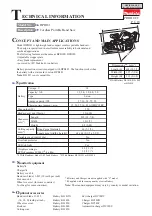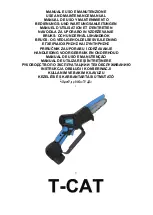
En 5 / 56
Fig. A
4-3.Installation:
(1)
Always
Keep proper footing & balance while
moving this 208kgs machine. Hang the
machine up, away from the floor, take away
the 4 pads and assemble them on the
auxiliary stand. Fix the machine on the
auxiliary stand and lock the connection nut.
(2)
Finish
removing this wooden case/crate from
the machine. Unbolt the machine from the
crate bottom.
(3)
Position
& tighten 4 bolts into base holes
properly after machine in balance.
(4)
Turn off
the power before wiring & be sure
machine is in proper grounding.
Overload & circuit breaker is recommended
for safety wiring.
(5)
Keep
machine always out from sun, dust, wet,
raining area.
Fig. B
4-4.CLEAIG & LURICATING
(1) Your machine has been coated with a heavy
grease to protect it in shipping. This coating
should be completely removed before
operating the machine. Commercial
degreaser, kerosene or similar solvent may
be used to remove the grease from the
machine, but avoid getting solvent on belts or
other rubber parts.
(2) After cleaning, coat all bright work with a light
lubricant. Lubricate all points . with a medium
consistency machine oil.
5. MAKE PROPER TOOTH SELECTION
For maximum cutting efficiency and lowest cost
per cut, it is important to select the blade with the
right number of teeth per inch (TPI) for the material
being cut.
The material size and shape dictate tooth selection.
TOOTH
SELECTION
You need to consider:
The width of the cut -
That is, the distance in the
cut that each tooth must travel from the point it
enters the work-piece until it leaves the work-piece,
and
1. The shape of the work-piece.
z
Squares, Rectangles, Flats (Symbol :
■
)
Locate the width of cut on the chart. (Inches
on the outer circle and millimeters on the inner
circle.) Select the tooth pitch on the ring
marked with the square shape which aligns
with the width of cut.
EXAMPLE: 6" (150mm) square, use a 2/3
Vari-Tooth.
z
Round Solids (Symbol :
●
)
Locate the diameter of your work-piece on the
chart. Select the tooth pitch on the ring
marked with the round shape which aligns
with the size of stock you are cutting.
EXAMPLE: 4" (100mm) round, use a 3/4
Vari-Tooth.
z
Tubing, Pipe, Structural ( Symbol : O H ^ )
Determine the average width of cut by dividing
the area of the work-piece by the distance the
saw blade must travel to finish the cut. Locate
the average width of cut on the chart. Select
the tooth Ditch on the ring marked with the
Содержание SX-824DG
Страница 49: ...47 56...
















































